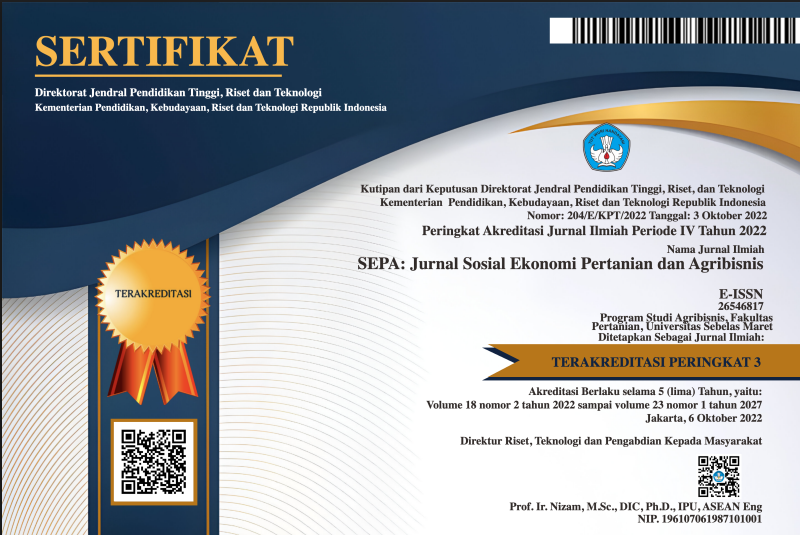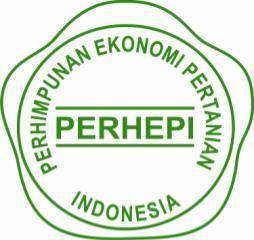DAMPAK PENINGKATAN KONSUMSI KARET ALAM DOMESTIK TERHADAP KESEJAHTERAAN PETANI KARET INDONESIA
Abstract
Rubber is a people's commodity that contributes greatly to the Indonesian economy. However, the price of natural rubber fluctuates with a downward trend, thus affecting state income and the welfare of Indonesian rubber farmers. Therefore, the natural rubber-producing countries in the ITRC forum agreed to increase domestic natural rubber consumption in their respective countries as an effort to stabilize the price of rubber in the world. This policy was later referred to as the Demand Promotion Scheme (DPS). This study aims to see the impact of the application of DPS as a domestic natural rubber trade policy on the welfare of Indonesian rubber farmers. The analysis uses an econometric model in the form of a system of simultaneous equations which is estimated by the Two-Stage Least Squares (2SLS) method using the 1992–2017 annual data series. The results of this study indicate that the implementation of policies to increase domestic natural rubber consumption can improve the welfare of Indonesian rubber farmers.
Keywords
Full Text:
PDFReferences
Direktorat Jenderal Perkebunan. (2018). Statistik Perkebunan Indonesia 2015 –2017: Karet [internet]. Retrieved from
http://ditjenbun.pertanian.go.id
Purwaningrat, L., Novianti, T., Dermoredjo, S. K.: Dampak Peningkatan Konsumsi Karet Gabungan Perusahaan Karet Indonesia. (2019). Informasi Pasar dan Perkembangan
Karet. Retrieved from https://gapkindo.org/.
Ginting, A. M. (2013). Pengaruh Nilai Tukar Terhadap Ekspor Indonesia. Buletin Ilmiah Litbang Perdagangan, 7(1).
Harder, M. (2018). Natural Rubber Vs Synthetic Rubber – The Price Relationship and Demand Switchability [internet]. Retrieved February 19, 2019, from https://www.halcyonagri.com/natural-rubber-vs-synthetic-rubber-the-pricerelationship-and-demand-switchability/
Indonesia Eximbank Institute. (2019). Proyeksi Ekspor Berdasarkan Industri: Komoditas Unggulan. Jakarta: Indonesia Eximbank.
Kementan. (2020). Kementerian Pertanian -DATA LIMA TAHUN TERAKHIR. Retrieved April 17, 2020, from https://www.pertanian.go.id/home/?show=page&act=view&id=61
Nurhidayati, I. (2013). Analisis integrasi pasar karet alam antara produsen utama dengan pasar berjangka Singapura dan Jepang [Tesis]. Bogor.
Prabowo, Y. (2017). Analisis permintaan ekspor karet alam Indonesia ke negara China, Jepang, Kanada dan Amerika
Serikat [Tesis]. Yogyakarta.
Pusat Data dan Sitem Informasi Pertanian. (2017). Outlook Komoditas Pertanian subsektor Perkebunan. Jakarta:
Kementerian Pertanian.
Simatupang, P. (2007). Analisis Kritis terhadap Paradigma dan Kerangka Dasar Kebijakan Ketahanan Pangan Nasional.
Jurnal Forum Penelitian Agro Ekonomi, 25(1), 1–18.
Sinaga, B. M. (1989). Econometric model of the Indonesian hardwood products industry. A Simulation Policy Analysis
[Dissertation]. Los Banos.
Tety, E. (2002). Penawaran permintaan karet alam Indonesia di pasar domestik dan internasional [Tesis]. Bogor.
Welatama, A. (2017). Dampak Kebijakan International Tripartite Rubber Council dalam Membatasi Kuota Ekspor Karet
Alam terhadap Indonesia. JOM FISIP, 4(2), 1–8.
DOI: https://doi.org/10.20961/sepa.v17i2.42198
Refbacks
- There are currently no refbacks.



.png)







.png)
3.png)





